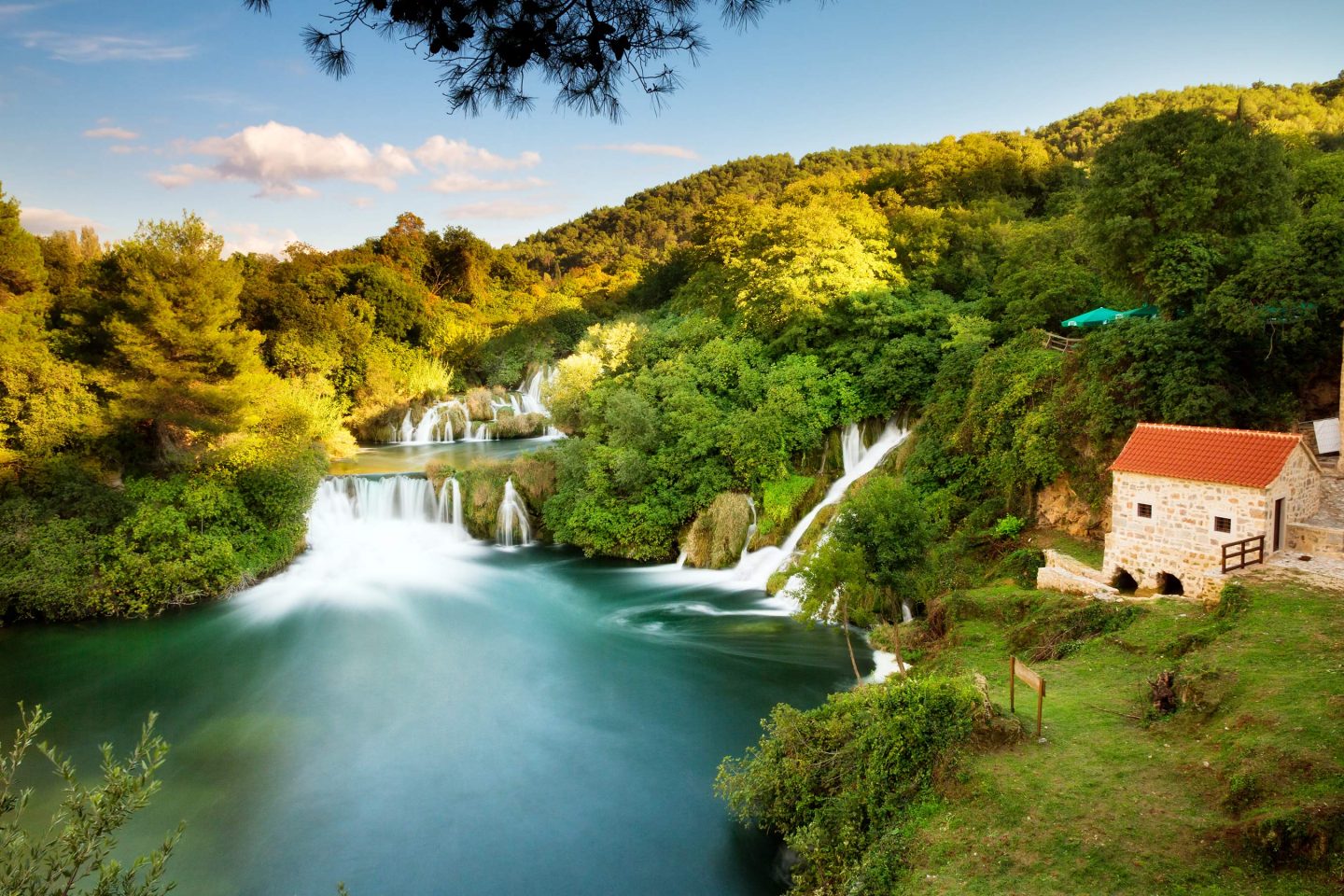How to Photograph Waterfalls
In 2008, an artist by the name Olafur Eliasson created one of the most expensive art public art projects of all time. He built four waterfalls in New York City. With the support of the Public Art Fund, he brought in engineers, environmentalists, scientists, and other professional to help bring his dream to life. The falls were in operation for almost four months, and they cost more than 15 billion dollars.
My favorite line about the now-famous project is from a June 2008 conversation between Eliasson and writer Carol Vogel of The New York Times. When asked about his work, the artist said, «Viewers will be seeing something they know from a picture, but now they will be experiencing them as a physical thing.»
He was onto something. Most of us, especially those of us who live near big cities, don’t often get the chance to interact with waterfalls. Most of us will see the Earth’s most extraordinary waterfalls not in person but in photographs.
That’s why we asked six outstanding photographers from around the globe to tell us their best and most epic waterfall stories. Through their eyes, we get up close with some of the planet’s greatest wonders. They also shared some tricks and tips for shooting the perfect waterfall, whether it’s in your backyard or halfway around the world.
1. To capture the magic of this place, I’ve worked a lot with my Big Stopper to create silky smooth water with long exposures.
Dennis van de Water

Image by Dennis van de Water. Gear: Canon 7D camera, 15-85mm lens. Settings: Focal length 15mm; exposure 30 sec; f16; ISO 400.
What’s the story behind this photograph?
This is a long-exposure with a B+W 10-stop filter. My girlfriend and I had just come from Plitvice, and we had never heard of Krka before. A local recommended it, and we just drove there, not knowing what to expect. When we came to this beautiful place, full of waterfalls and empty of tourists, we were surprised by the tranquility. It’s not just the beauty of the place but also the experience of your travel adventure that contributes to an image.
What is your favorite waterfall you’ve ever photographed?
We don’t have any waterfalls in the Netherlands since it is as flat as a dime, so I actually like every single waterfall, but I have to say that my favorites are the waterfalls of Krka National Park in Croatia. This area is not far from the world-famous waterfalls of Plitvice, but it is less touristic. The place has a nice and relaxing atmosphere, especially early in the morning with beautiful, soft light.
You can take a boat up the river towards the lower falls and take a short but beautiful hike through the park over well-built wooden footpaths leading to various cascades and historic buildings, including one of the oldest hydroelectric power-generating facilities in the world.
Pro Tip
To capture the magic of this place, I’ve worked a lot with my Big Stopper to create silky smooth water with long exposures. When photographing in a forest, where the light is minimum, just a polarizing filter can be sufficient, but here in the open, a dark filter was needed. Be careful with big falls and filters; when you come too close, they tend to get wet from the spray.
Where do you find inspiration for your photography?
I love to travel and to be outside, even here in the city of Amsterdam. I would say my inspiration comes from the places I visit, the things I see, and whatever I encounter on my endeavors, big or small.
2. «Awesome waterfall photographs must be taken in the late rainy season because that’s when there is a lot of clear water.»
Tzido Sun
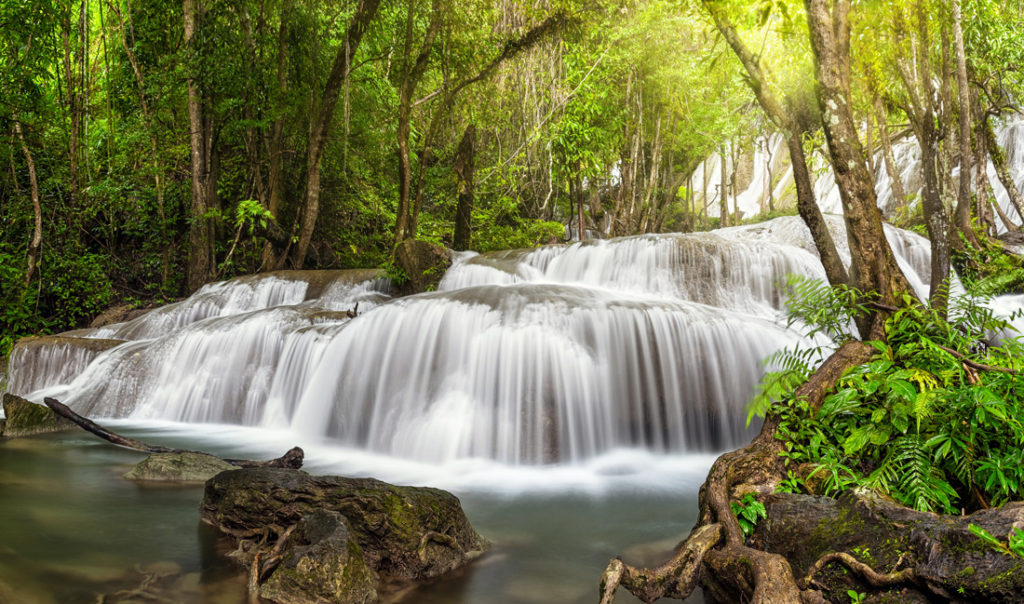
Image by Tzido Sun. Gear: Pentax K-3 II camera, Sigma 17-70mm f/2.8-4 DC Macro OS HSM lens. Settings: Focal length 17mm; exposure 10 sec; f8; ISO 100.
What’s the story behind this photograph?
I shot this scene at almost six o’clock in the evening, which is a great time to take waterfall photos. I used a shutter speed of 10 seconds, without any ND filter. I also used a special technique for this shot: I took two photos and processed them by using the panorama function in Lightroom. This makes the image look wider.
What is your favorite waterfall you’ve ever photographed?
Pha Tat Waterfall in Kanchanaburi province, Thailand, is one of the best tourist attractions in the area, and it’s only about three kilometers from the National Park Office. The limestone cascade is a single layer, and then the water cascades down three levels. The highlight of the waterfall is on the third level, where you can see the water flowing down. The waterfall has a width of more than 10 meters.
Pro Tip
Awesome waterfall photographs must be taken in the late rainy season because that’s when there is a lot of clear water. Study the location to determine what time period is appropriate and in what direction the sun rises and sets.
Use a low shutter speed to get a smooth waterfall, based on the environment. Required equipment includes a camera with a wide-angle lens, a tripod, an ND filter or a polarizing filter, and a remote shutter release
Where do you find inspiration for your photography?
Often, I see pictures on websites about photography, travel, and microstock, especially in Europe, America, or some regions in China. Since I am a photographer from Thailand, I try to think of the beautiful places in Thailand, places that are typical of Southeast Asia. I shoot a lot, and I practice, with the goal of one day journeying to the places in my dreams.
3. Use a wide angle lens for getting the whole scene, and use ND filters if you want to smooth out the water
Gail Johnson
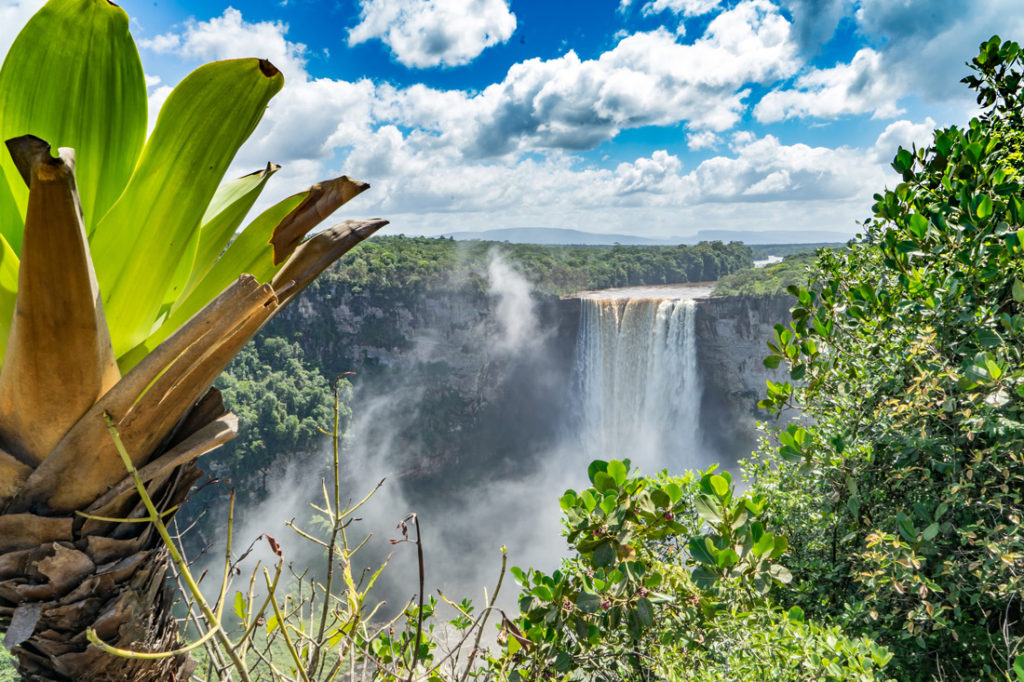
Image by Gail Johnson. Gear: Sony A7II camera, 24-70mm lens. Settings: Focal length 24mm; exposure 1/400 sec; f14; ISO auto (100).
What’s the story behind this photograph?
In this shot, I wanted to frame the waterfall, as I had taken so many of the whole thing from top to bottom. The issue was getting far enough back to get everything in focus, but not so far back the waterfall disappeared. The group was small, so there was no problem with other people getting in the way, etc.
At one stage, we were on top of a cliff face, with no barriers and nothing to stop you falling hundreds of feet. I had someone holding onto the back of me in order to get close enough safely.
What is your favorite waterfall you’ve ever photographed?
Kaieteur Falls are miles into the interior of Guyana, so you had to take a very small plane and land at the top of the falls (it’s a dirt landing strip), and you then trek around until you get good views. I currently live on a small island, so we don’t even have rivers or streams, let alone waterfalls. This made it even more special.
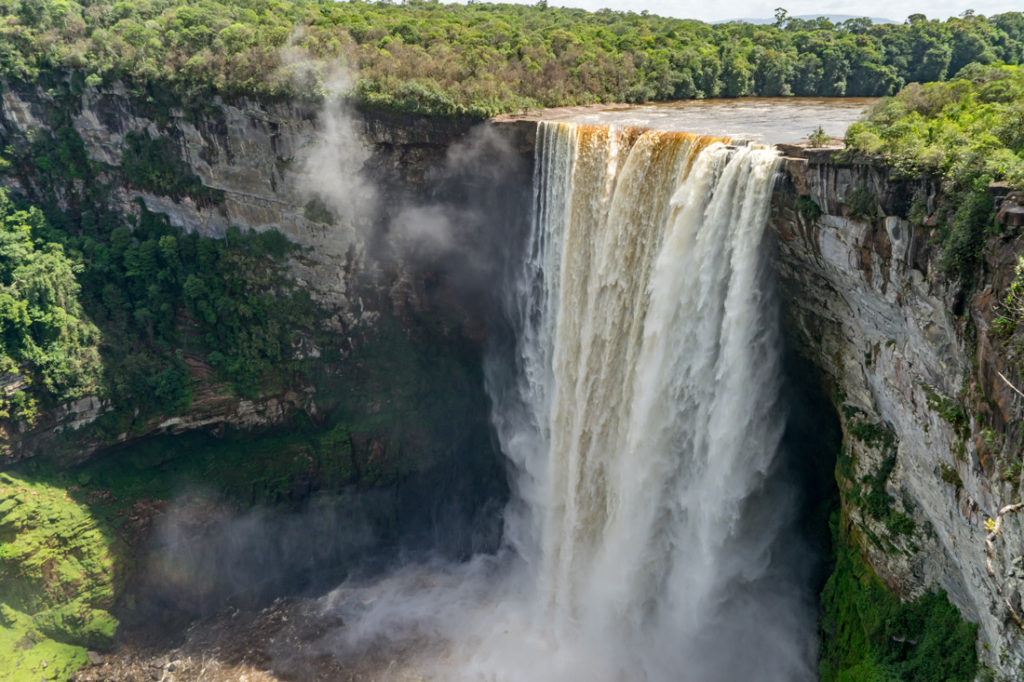
Pro Tip
Water spray can be a real issue, so make sure you have a lens hood and a cloth that can be used to dry the lens; you can use things like shower caps to cover the lens until you’re ready for the photo.
Use a wide angle lens for getting the whole scene, and use ND filters if you want to smooth out the water. I love the mirrorless full-frame camera. Since I have switched to mirrorless, I have not had to visit a chiropractor, and I am so happy having a lighter bag when traveling.
Bring some Wellington boots if you are at the bottom of the falls and it is safe to enter the water. I have been known to use a waterproof camera and get very close, but it has to be the right waterfall.
Have a companion. I either have my very patient husband, or I often run free photo walks and day trips to places I want to photograph but don’t want to visit alone. That way I have company, but as the trips are free, I do not feel any guilt in taking photos the whole time.
Where do you find inspiration for your photography?
I just love the reaction from people on Facebook, etc, to my photos. I also love the fact that magazines come to me, rather than me going out touting for work.
4. A good tripod is a must to stabilize the camera
Songquan Deng
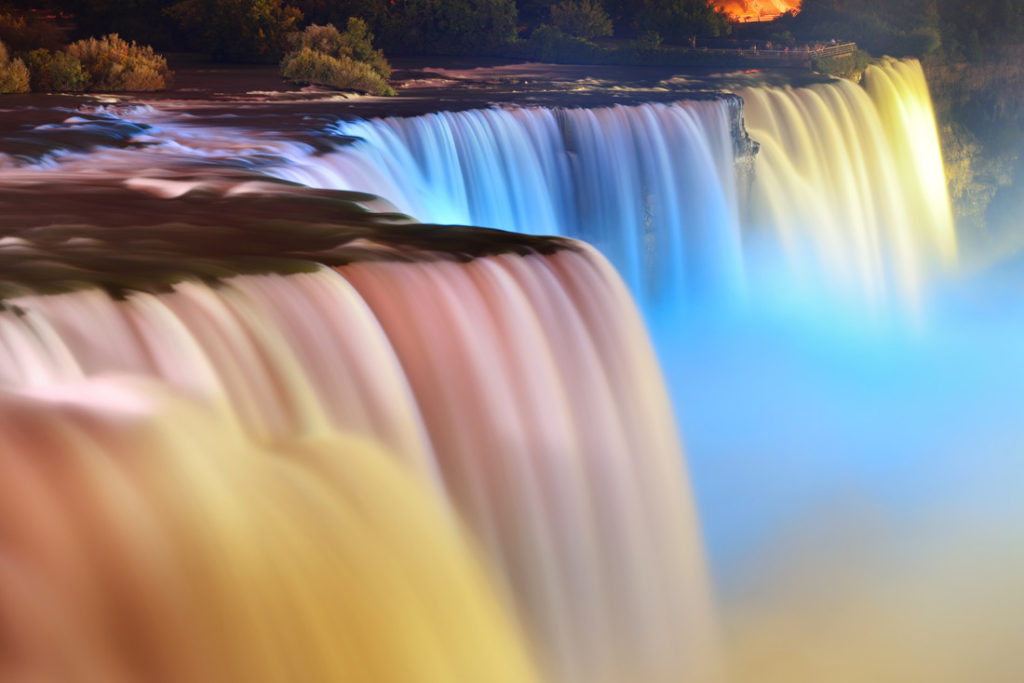
Image by Songquan Deng. Gear: Nikon D800 camera, 70-200mm f2.8 lens, and a tripod. Settings: Focal length 116mm; exposure 3 sec; f5; ISO 200.
What’s the story behind this photograph?
This shot was taken in 2012. I had just gotten my Nikon D800, the 36mp full-frame camera with the highest resolution in the full-frame market at that time. I took with me in my two-week road trip to Canada with my family. After dark, colorful lights were projected onto the water streams and created such an unforgettable lighting experience. The fast moving streams changed into an abstract painting with colors and light gradients.
What is your favorite waterfall you’ve ever photographed?
Niagara Falls is the most impressive one I’ve ever seen. It’s big and is amazingly colorful at night.
Pro Tip
First, be safe. Many waterfalls are located deep in the mountains with cliffs, rocks, and rapids. Make sure where you stand is absolutely safe.
Experiment with different shutter speeds. Slower speeds capture the creamy, silky feel of the falling water. If it is too slow, however, it will kill the details of the silky stream. Find your own preferred shutter speed. ND or CPL filters will be necessary when the light is way too bright to bring down the shutter speed.
When you get close to the waterfall, the moisture and steam from the falling water quickly covers the lens and blurs the image. I hold a cloth and clean it from time to time. The rapids in which I set my tripod can cause a bit of an issue as well. A good tripod is a must to stabilize the camera.
Where do you find inspiration for your photography?
I travel to different countries and cities to get in close touch with their culture, people, architecture. Those things provide fresh inspiration for my photos. When I am not traveling, I browse other photographers’ work at sites like Flickr, 500px to study their perspectives and ideas.
5. Curioso
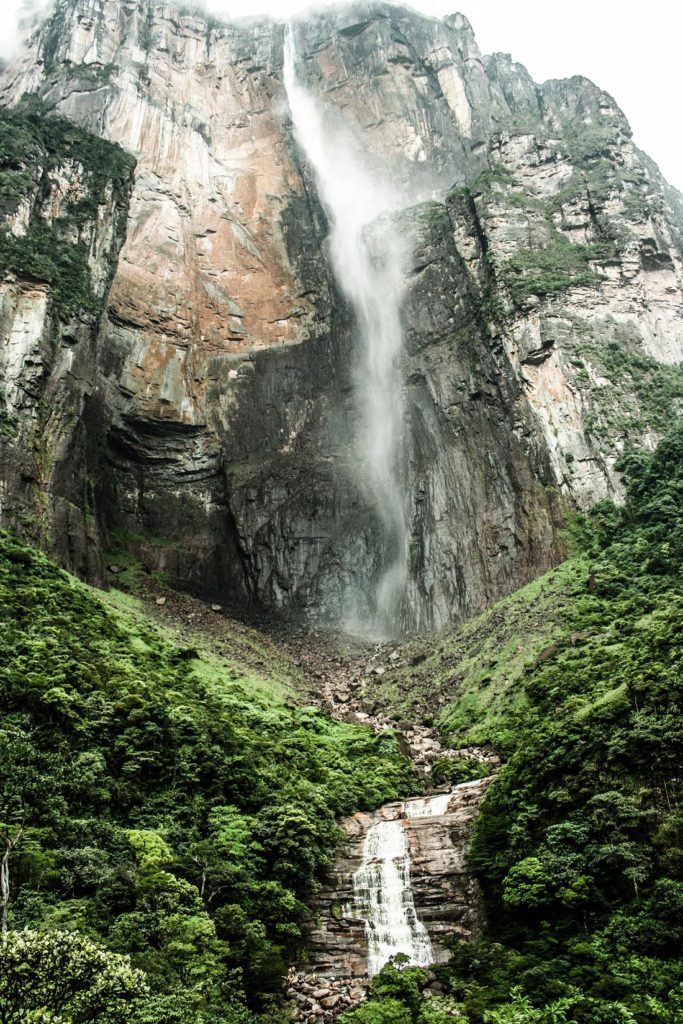
Image by Curioso. Gear: Canon 350D camera. Settings: Focal length 18mm, exposure 1/250 sec; f5; ISO 400.
What’s the story behind this photograph?
This waterfall is very tall, and it is not easy to get it all in one picture. It was the first waterfall I ever photographed. We slept in a hammock. At night, it can get very noisy in the jungle. I tried not to think about all the wild animals around me.
What is your favorite waterfall you’ve ever photographed?
Waterfalls are like the heart of the jungle. My favorite waterfall is Salto Angel (Angel Falls) in Venezuela, inside the jungle in Canaima National Park. It takes all day to get there, and it’s not easy. First, you need to take a boat up the river for many hours. Then, you need to walk across the jungle, which is amazing. You can find many insects and spiders there.
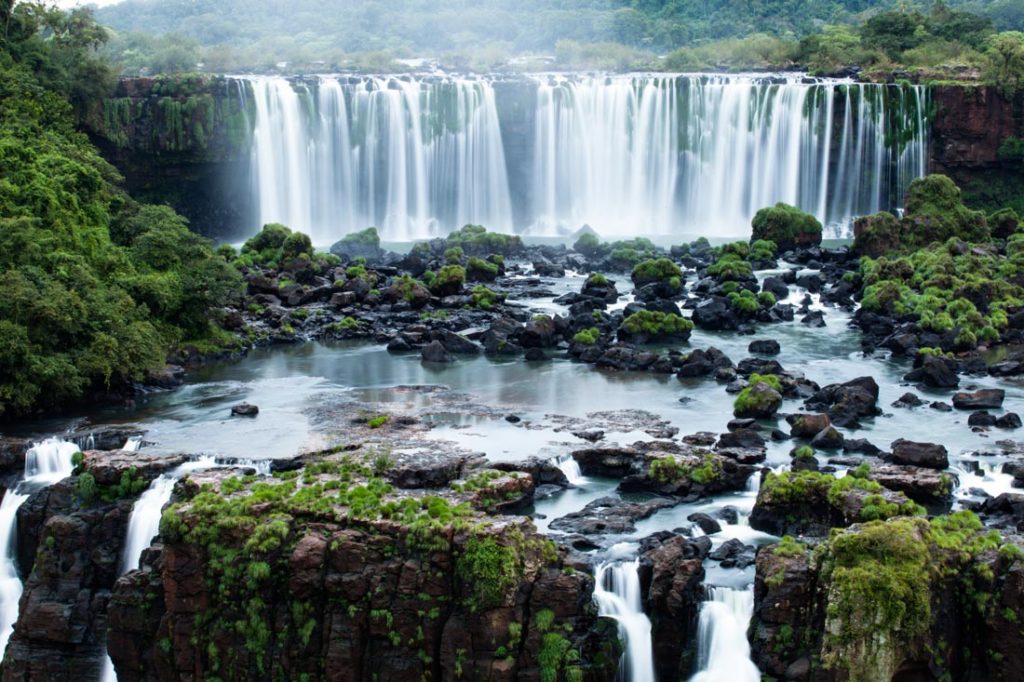
Image by Curioso. Gear: Canon 5d Mark II camera, Canon 70-200mm f/4 lens. Settings: Focal length 200mm, exposure 2.5 sec; f32; ISO 50.
Pro Tip
You need to be well equipped, and you need to protect your camera from rivers, rain, and evaporation.
This second image was made on the Brazilian side of the Iguazu Waterfall. Behind any picture made in the Amazon Jungle, there are thousands of mosquitos. After the mosquitos, the heavy rain comes, and then the sun. Everything evaporates, including you.
This is dangerous for cameras. Even new cameras have problems with evaporation. The next day, when I needed to make pictures from the other side of the waterfall, the Argentina side, I discovered that my camera was broken. It was a real pity for me. I did buy a new camera in Paraguay, and I continued with my travels. But there was no time to go back to see the waterfall.
Where do you find inspiration for your photography?
I am a traveler. I have been traveling since 2004, and I have been to more than 83 countries in six continents. I have seen many famous waterfalls, including Victoria Falls in Zambia, Niagara Falls in the US and Canada, Russell Falls in Tasmania, and the Kamienczyk Waterfall in Poland.
6. Find a new perspective to take pictures
Suwit Ngaokaew
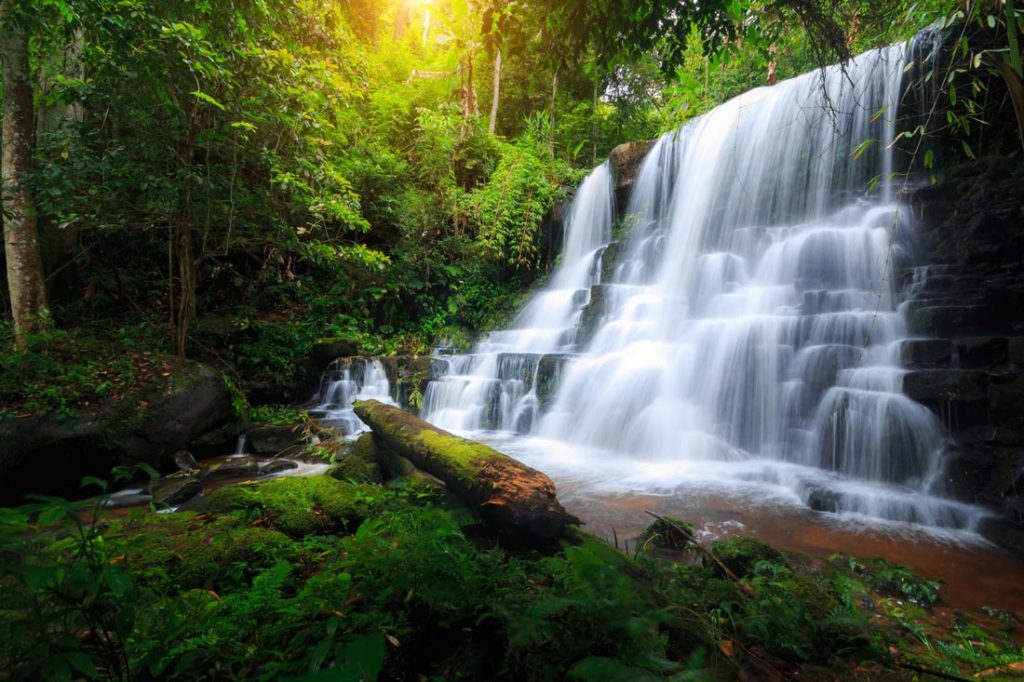
Image by Suwit Ngaokaew. Gear: Canon EOS 70D camera, Sigma 10-20mm f/4-5.6 lens. Settings: Focal length 10mm, exposure .6 sec; f13; ISO 100.
What’s the story behind this photograph?
Mun Daeng Waterfall is most beautiful during the rainy season, and the trouble of slippery terrain is worth it.
What is your favorite waterfall you’ve ever photographed?
Mun Daeng Waterfall is located in the center of Phu Hin Rong Kla National Park in Thailand. It is beautiful but not easy to visit, so I had to travel with a guide to find it.
Pro Tip
Find a new perspective to take pictures. All light conditions will affect your photographs, and it’s hard to photograph waterfalls in the sun. That’s why the rainy season is ideal. Follow the weather and research the perfect times to visit. If the light is still strong, I will use filters help reduce the brightness.
Where do you find inspiration for your photography?
I like nature, and I read travel magazines to find waterfalls that I want to photograph. In the beginning, I tried to follow their techniques, and then I fell in love with waterfalls for myself.
See also: Travelin photography
